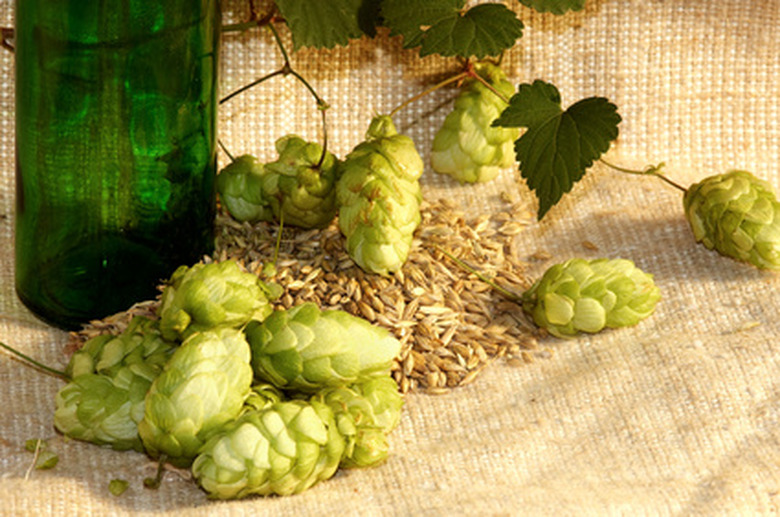Growing Hops In Washington
Things Needed
- 10- to 15-foot trellis or fencing
- Hops rhizomes
- Clippers
- Twine
- Drip or soaker hoses
- Fertilizer
- Mulch
Hops are used in beer production to give beer flavor. Since the 1990s, a niche market for organic hops has opened up for microbrewery and home brewers, making Washington a major center of organic hops production. The hotter, drier areas of the Pacific Northwest along the coast and east of the Cascades are well-suited to growing hops, which are susceptible to mold and disease in more humid areas. Hops can be grown in fields or along fences and balconies in backyard gardens.
Step 1
Build the trellising for your hops plants before planting them. Trellises need to be 10 to 15 feet tall with a few feet of space around each plant. Tall tepee trellises work well, or the plants can be trained along a fence or balcony railing. For easier harvest, hops on farms are trellised on fence wires that run between tall posts.
- Hops are used in beer production to give beer flavor.
- For easier harvest, hops on farms are trellised on fence wires that run between tall posts.
Step 2
Place the trellises in an area that gets at least six to eight hours of sunlight each day. The plants should also be protected from strong winds, which can knock them over. Hops need to be planted in well-drained soil, as standing water can attract mildew and other diseases.
Step 3
Plant hops rhizomes in the spring, as soon as the soil can be worked and the last chance of freezing has passed. In Washington, plant hops outdoors in March or April, depending on your climate and frost dates. In colder regions of Washington, hops can be planted in pots indoors and transplanted outside as late as June. Place field rows 8 feet apart, with hills placed 2 or 3 feet apart.
- Place the trellises in an area that gets at least six to eight hours of sunlight each day.
- In Washington, plant hops outdoors in March or April, depending on your climate and frost dates.
Step 4
Plant two rhizomes in each hill. Place the rhizomes in the soil vertically, with the bud pointing up, and cover them with 1 inch of soil. Keep the soil moist during the first year of growth but avoid over watering.
Step 5
Begin training the hops vines when they are about 2 feet tall, which is generally around May in Washington. Choose three or four of the strongest vines and prune off the weaker ones. On a balcony, tepee or fence, you can train the vines by wrapping the ends clockwise around the trellis. For field trellises, tie pieces of twine to a stake in the ground and run it up to the overhead wire, then wrap the vines clockwise around the string.
- Plant two rhizomes in each hill.
- Place the rhizomes in the soil vertically, with the bud pointing up, and cover them with 1 inch of soil.
Step 6
Check the vines regularly to make sure they are staying on the trellis. Once the vines have grown about 10 feet tall, thin out the undergrowth to promote good air circulation, prevent tangling, and discourage mold.
Step 7
Water established hops at the ground with a drip or soaker system. Hops need about 1.5 inches of water each week.
Step 8
Fertilize hops with a balanced fertilizer that is not too high in nitrogen. Plants should be fertilized in the spring when growth is beginning and again in late summer when the cones begin to appear.
Step 9
Harvest the hops when the cones feel dry and spring back when you squeeze them. Ripe hops cones have a fragrant sticky substance near the base that is released from golden-colored glands. In Washington, the harvest begins at the end of August and continues until early October.
- Check the vines regularly to make sure they are staying on the trellis.
- Once the vines have grown about 10 feet tall, thin out the undergrowth to promote good air circulation, prevent tangling, and discourage mold.
Step 10
Snip individual cones from the vines, or cut off whole vines and remove the cones later. Don't expect much of a harvest in a hops plant's first year. In subsequent years, plan to harvest the plant several times as cones don't all mature at once.
Step 11
Cut hops vines down to 2 feet long after the harvest is finished. Lay them on the ground and bury them in several inches of mulch to protect them from hard winter freezes.
